Welcome to Old School Month on Eternal Central. We’re looking at a different Old School 93-94 deck each day of the month. Today’s deck is Legendary Naya Bounce, named for playing Legendary creatures in the Naya colors (Red-Green-White), and bouncing them with Karakas.
This deck is a fun one that plays a handful of token-making Legendary creatures from the Legends set, and then uses Karakas to bounce them back to hand with the comes in to play trigger on the stack. Here are just a couple of the past versions of the deck I have played with locally.
My Hazezon Karakas v3.0 deck from Chicago #OldSchoolMTG last week. Bounce Stangg or Hazezon with CIP trigger on the stack, profit. #MTGPEEMP pic.twitter.com/vwOrTZii4X
— Jaco (@JMJACO) April 4, 2017
My #OldSchoolMTG Hazezon Karakas deck from Milwaukee brewery tour & fish fry get together last weekend. Lots of suboptimal choices, but fun. pic.twitter.com/cNBuMqO9H9
— Jaco (@JMJACO) March 15, 2017
Constructing Legendary Naya Bounce
This deck originally began as a project to use Mana Flare to power out some of the more exotic (and higher casting cost) creatures with comes in to play effects that could be combined with Karakas. In one of the versions above, you can see a few Mana Flares present. But as anyone who has played with Mana Flare can tell you, it is a double-edged sword, in that its symmetric effect also benefits the opponent, who can often times take better advantage of the mana, especially if you are playing Mana Flare in a non-blue deck with cards that could described as average, at best.
So the deck quickly turned to Gauntlet of Might for additional mana production. Not only does this make Mountains produce an additional mana, but it also gives Red creatures +1/+1, which has synergy with many of the creatures we play, which we will discuss in a bit. Here is another version from the testing laboratory.

Creature Choices
The creatures in this deck are mostly legendary, in order to protect them with Karakas. Many have comes in to play abilities, and Karakas can be used to bounce them back to the hand, once they have resolved, and while the comes in to play trigger is still on the stack.
Stangg is a 6 mana dudesweat, with the following Oracle text: “When Stangg enters the battlefield, create a legendary 3/4 red and green Human Warrior creature token named Stangg Twin. When Stangg leaves the battlefield, exile that token. When that token leaves the battlefield, sacrifice Stangg.” As the rulings on the Gatherer page indicate, “If Stangg leaves the battlefield before its ability has resolved, that ability will still create a Stangg Twin token, but its delayed triggered abilities will never have a chance to trigger. That token will remain on the battlefield indefinitely (until it’s dealt lethal damage, or anything else causes it to leave the battlefield).” This is great with Karakas, because we can cast Stangg, and then bounce it back to hand with Karakas to leave behind the token (which will have no memory of being a “twin”), and then rinse and repeat on future turns for advantage. Because these are 3/4 red and green tokens, they will be pumped +1/+1 for each Gauntlet of Might you have in play, creating larger stand-alone threats that stand up to most of the threats in 93-94, and must be dealt with on their own.
Hazezon Tamar is a legendary 7 mana dudesweat, with the following Oracle text: “When Hazezon Tamar enters the battlefield, create X 1/1 Sand Warrior creature tokens that are red, green, and white at the beginning of your next upkeep, where X is the number of lands you control at that time. When Hazezon leaves the battlefield, exile all Sand Warriors.” This has a delayed trigger that happens at the beginning of your next upkeep, and as the rulings on the Gatherer page indicate, “Only Sand Warriors that are actually on the battlefield when Hazezon Tamar leaves the battlefield are affected when its second ability resolves. If Hazezon leaves the battlefield after the delayed triggered ability created by its first ability triggers but before that ability resolves, its second ability triggers and resolves first, then the Sand Warriors are put on the battlefield. Those Sand Warriors will remain on the battlefield indefinitely.” So this means you can once again bounce Hazezon back to your hand with Karakas before the Sand Warrior tokens enter play, in order to shield them from Hazezon itself being destroyed.
One important distinction between the two of these is that Hazezon Tamar’s second ability will exile all Sand Warriors tokens in play, and not just the ones created most recently. Once again, the rulings on the Gatherer page provide clarity here for any question on the matter, stating “When Hazezon Tamar’s second ability resolves, all permanents with both the Sand and Warrior creature types are exiled, not just the Sand Warrior creature tokens it created. Permanents that have just one of those types are unaffected.” Having played this deck more and more, I think the right number of Hazezons is probably 2, as playing more than that can often stay clogged in your hand until the late game.
Sunastian Falconer is another on-color legendary creature that fits nicely in to this strategy, as it can not only be protected by Karakas (by bouncing it back to your hand after blocking, or in response to a removal spell), but it can also help provide more mana to power out to facilitate other operations in the deck (such as drawing cards with Jayemdae Tome, casting larger monsters, etc.).
Finally, Serra Angel is present as an efficient threat, and will often be used as a bait spell, to draw either countermagic or the first opposing Swords to Plowshares, such that your other threats will be able to be bounced with Karakas unimpeded. Just like the rest of the creatures in this build, Serra is out of Lightning Bolt and Chain Lightning range, intentionally.
Draw Engines
While this deck lacks the restricted blue bombs like Ancestral Recall, Time Walk, Timetwister, and Braingeyser, it utilizes Jayemdae Tome and Sylvan Library quite well. Sylvan also has synergy with the two copies of Mirror Universe present in the 75, allowing you to more aggressively draw and dig for cards sometimes. There are a lot of key permanents for the opponent to Disenchant, including these, mana accelerants, and Gauntlet of Might, so you’re more than likely to stick one in play for a while. I like some number of Avoid Fates in the main deck or sideboard, in order to shield your threats from removal.
Designing the Sideboard
Fighting blue decks like Blue-White control and the deck is always a challenge when you’re playing a slower non-blue deck, so that is the first thing I like to address with the sideboard. I usually include some mix of Red Elemental Blast, Dust to Dust, Avoid Fate, and Disrupting Scepter. You can take out a lot of dead cards like Swords to Plowshares when facing off against nearly creatureless decks, and trim 1-2 of the legendary threats so you don’t just sit there with the stuck in hand.
Fast decks like White Weenie and Zoo are best addressed with more removal spells like Earthquake and Wrath of God, as well as Preacher. These also serve as double-duty against the slightly beefier RUG and UGW decks laden with Arabian threats, and City in a Bottle is another great solution to help mitigate their threats.
Against a deck like Blue-Red Counterburn, Circle of Protection: Red and Greater Realm of Preservation are a nice countertactics in addition to the standard Red Elemental Blasts, while Mirror Universe is a massive bomb against them.
For all of the artifact-heavy creatures strategies, Dust to Dust and your other creature control can be sided in, and often create easy games for you, because you just have so much removal post-board.
Playing Legendary Naya Bounce
As described above, the most commons lines of play will be to slowly deal with threats using your removal, and then cast a sick legendary creature with a comes in to play ability, and then use Karakas to bounce it back to your hand with the trigger on the stack. This doesn’t always happen, but most of the time you can navigate the game state to this.
Keep in mind that Karakas is a legendary land, and this should affect your sequencing of land drops (both in order to sometimes shield Karakas from Strip Mine, or leading it out early in order to entice a Strip Mine, if you have a duplicate waiting in hand).
Gauntlet of Might is a very interesting card in this deck, because not only does each additional Gauntlet provide more mana for you, but each additional one also pumps all of your tokens +1/+1 each. That means if you cast a Hazezon Tamar with two Gauntlets in play, the Sand Warrior tokens that enter play will be 3/3 each, which is often enough to just kill the opponent in a single turn in the late game (if Hazezon is generating something like 7 tokens). Gauntlet also makes your Fireballs more lethal, and eases the use of Jayemdae Tome.
Like in any deck with Mirror Universe main deck, you can often more aggressively use your life as a resource if you’re confident you can get Mirror to resolve and stick around for a turn. After swapping life totals you can usually end the game with a single counterattack, or a Fireball to the dome. The more I play Mirror in this deck the more I like it, and may eventually make room for a second one in the main deck if my local metagame calls for it.
Ten Opening Hands with Legendary Naya Bounce
Here are ten randomly drawn opening hands with the deck (in order, and not manipulated in any way), and a few brief words with how I might look to play said opening hands.
Opening Hand 1
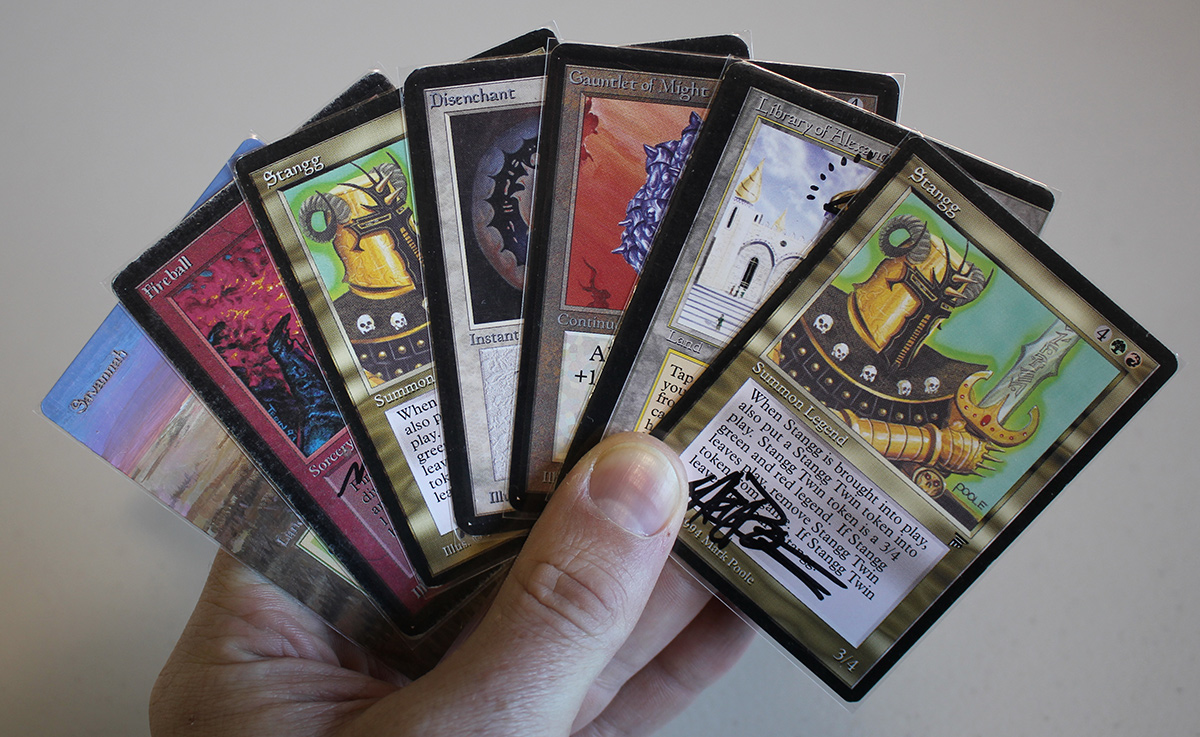
While this hand isn’t great, it does have a couple of mana sources, a Disenchant, and the best card in 93-94 (Library of Alexandria). It’s mediocre, but it’s a keeper.
Opening Hand 2

We have two lands present, which can both be used to cast our three cheap removal spells. This hand is average, but I’m going to keep it and just hope we draw mana in the first few turns to get Gauntlet in play, and then get Jayemdae Tome going (casting that second, essentially baiting removal or a counter with the Gaunlet).
Opening Hand 3
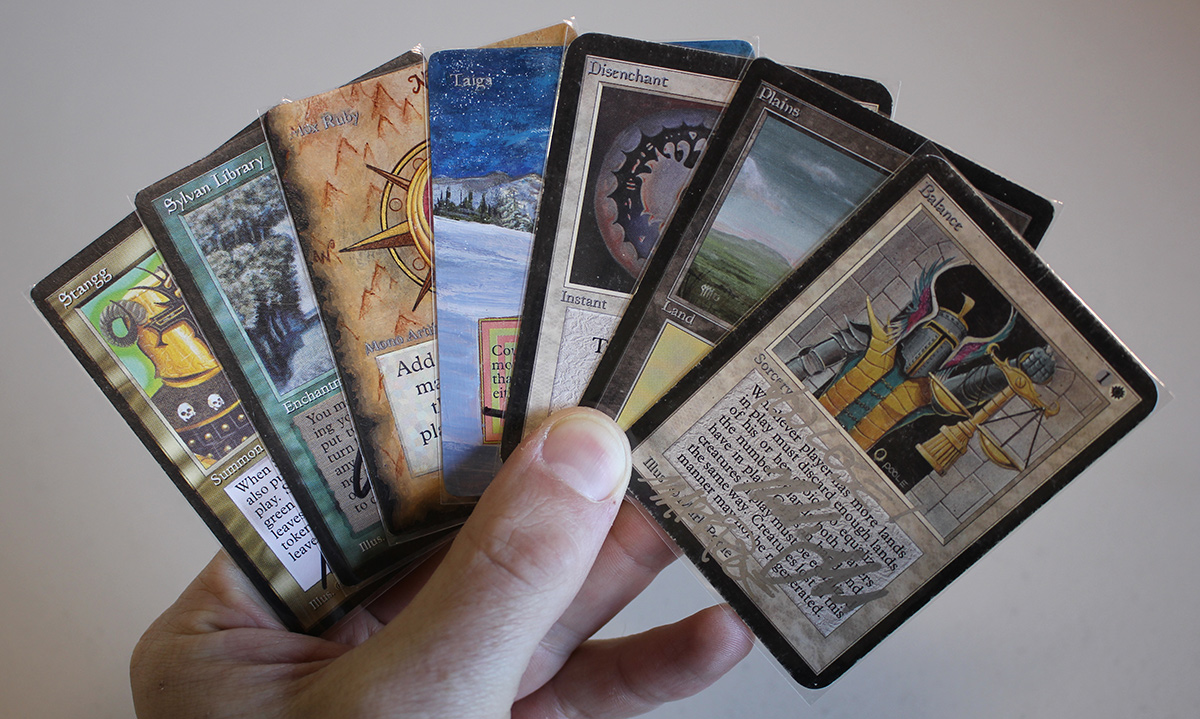
This hand features all of our deck’s mana colors present, as well as Disenchant, Balance, and Sylvan Library, making this an easy keep.
Opening Hand 4
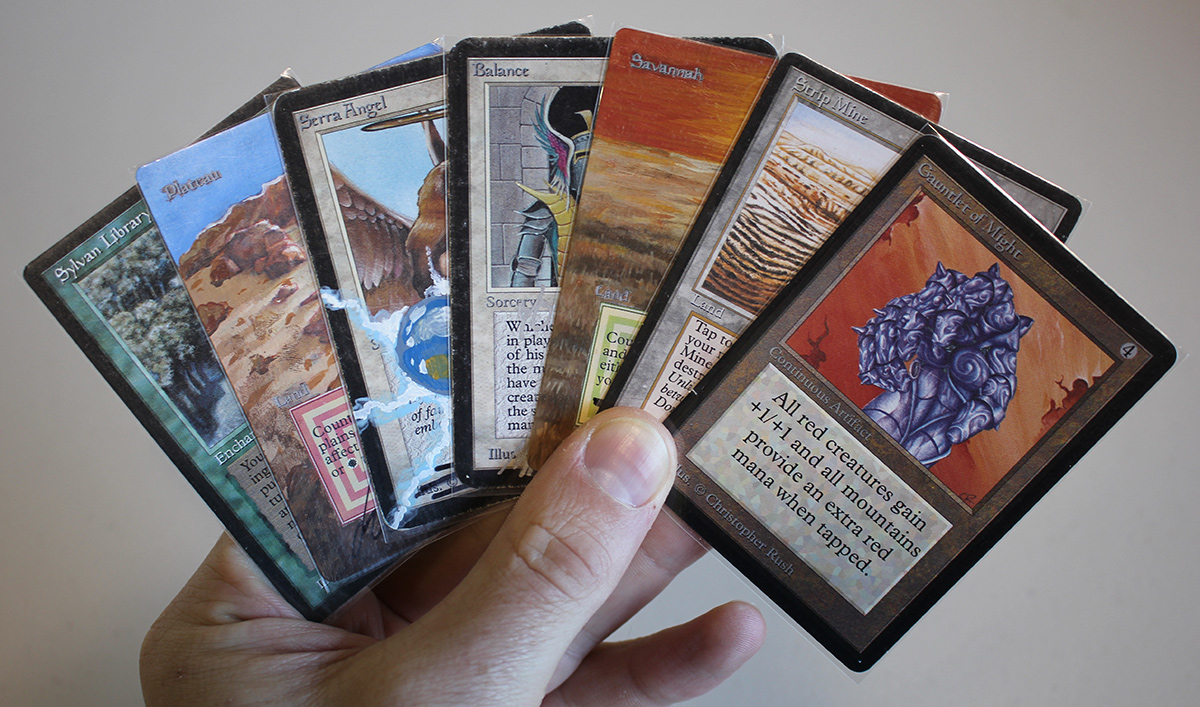
The presence of on-color mana, Strip Mine, Balance, and Sylvan make this a keeper. I’d probably lead with Strip Mine (in order to shield my more relevant colored mana in this case), and cast the Sylvan on the second turn (or might use the Strip Mine to tactically keep an opponent off of double blue mana and try to resolve it on the third turn if I suspect they have a Counterspell).
Opening Hand 5
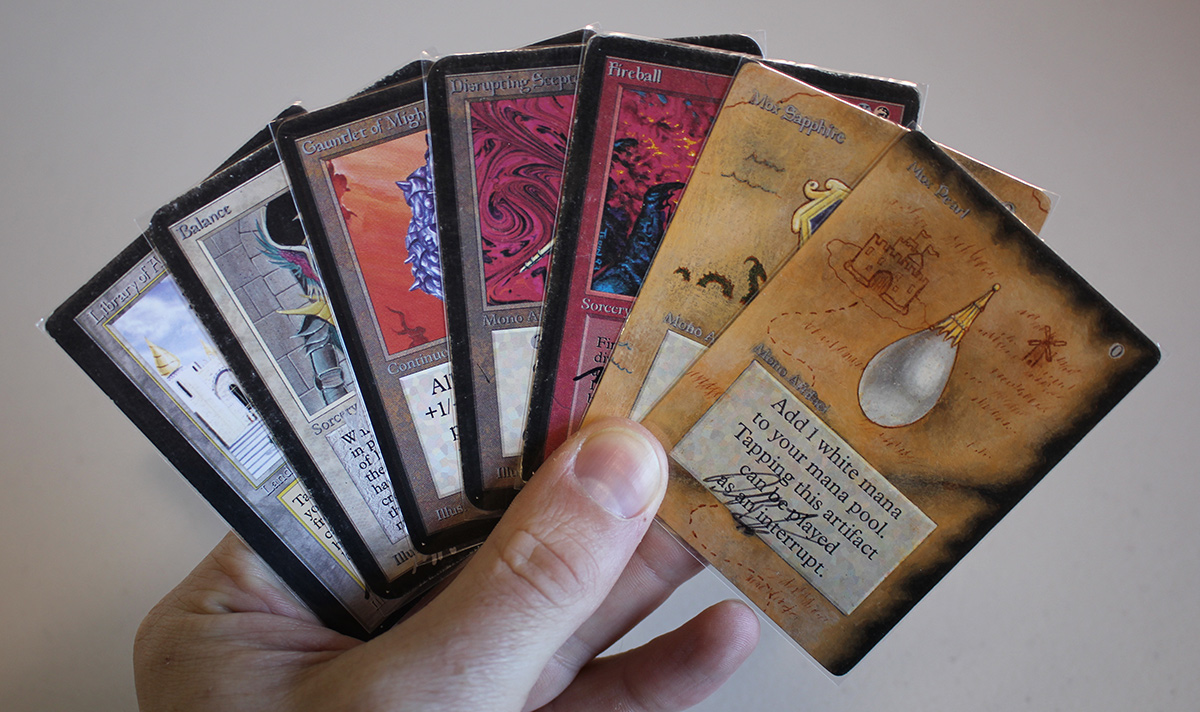
Library of Alexandria is present, as is fast mana and bombs. Even if Library gets dealt with immediately, this is already a solid hand by way of Balance and Disrupting Scepter.
Opening Hand 6
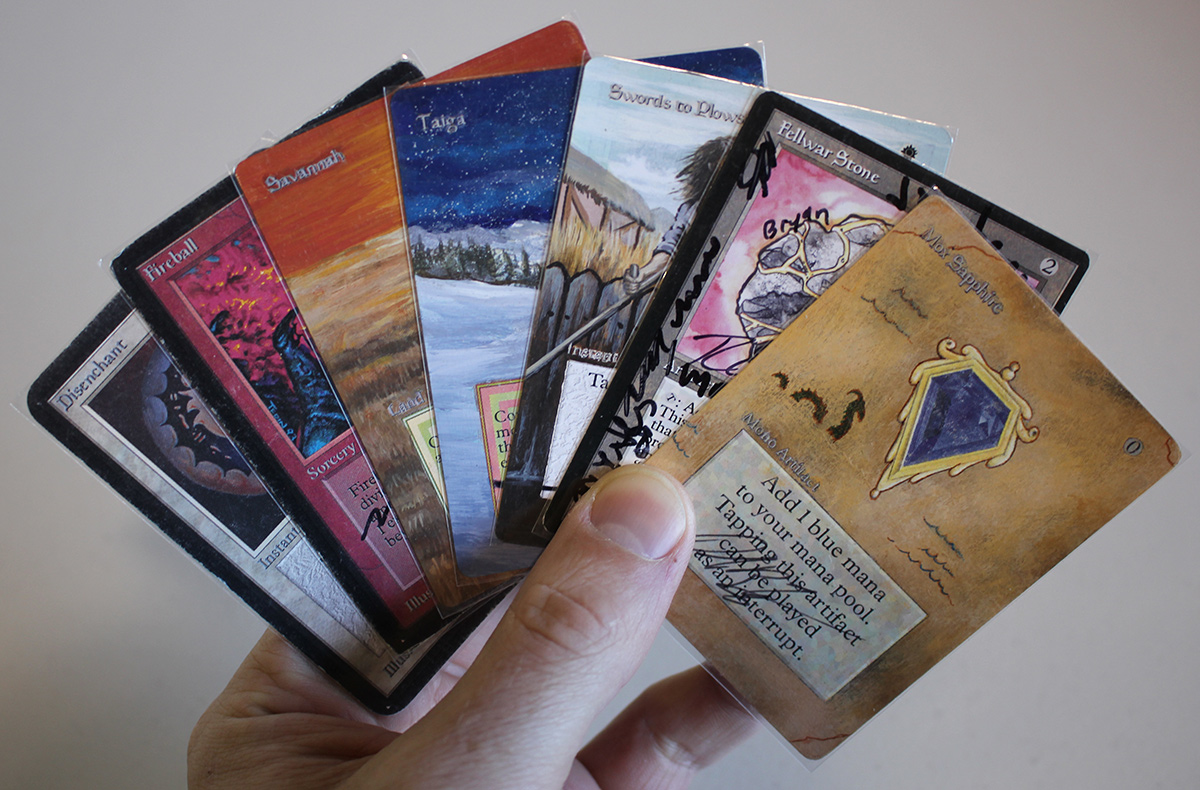
A solid if unspectacular hand featuring plenty of mana and removal. You will see hands like this all of the time, and while it’s certainly not as impressive as The Deck or a combo deck, this is what you’re signing up for when playing a non-blue deck.
Opening Hand 7
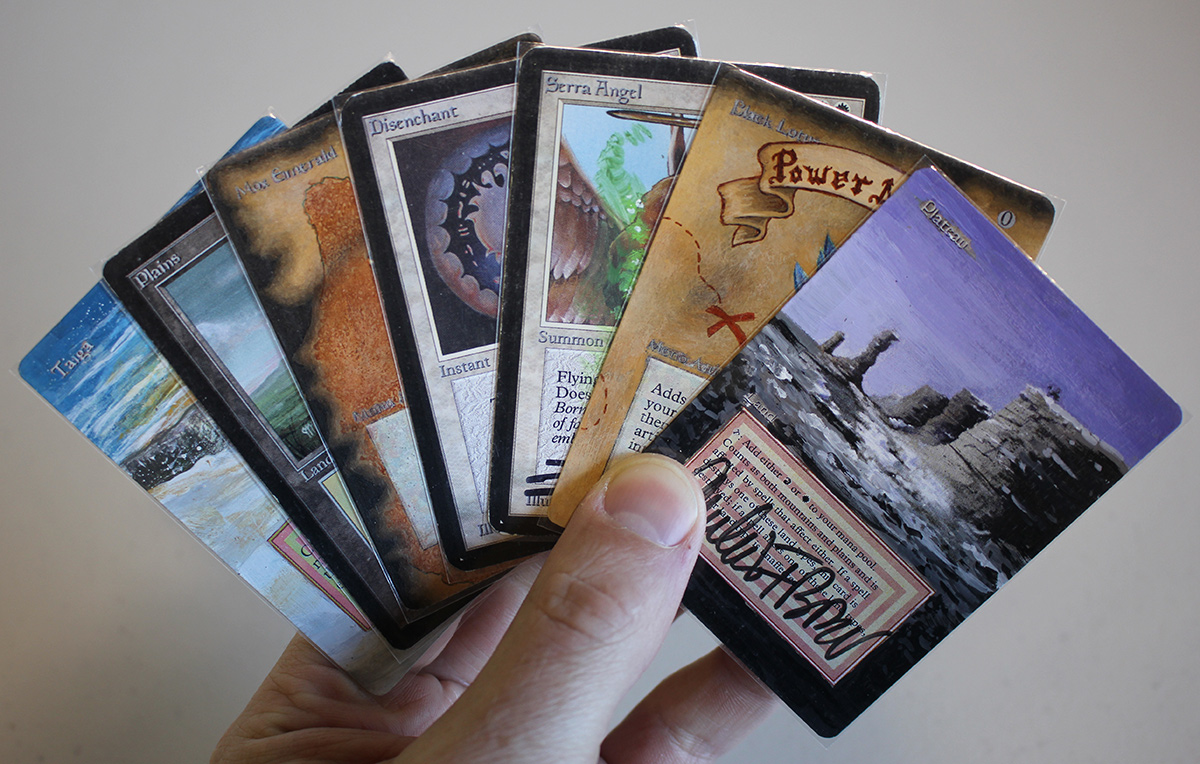
This hand represents a first turn Serra Angel, removal, and plenty of mana. I’ll happily keep this and run out Plains + Emerald + Lotus in to the Serra, with the expectation that it will promptly get Swords to Plowshared. If it doesn’t you will almost definitely win this game, and if it does you still have plenty of mana to cast everything else you’ll draw in the coming turns.
Opening Hand 8

With the good mana and the ability to drop a first turn Gauntlet of Might, this is a pretty solid hand, that represents a clear path to casting and bouncing Stangg repeatedly, with a Hazezon Tamar to follow up should that get dealt with. If you suspect that the opponent will only be able to deal with one creature, it may actually be correct to lead with the Hazezon if you though it would get Swordsed, in order to repeatedly cast Stangg on subsequent turns (and make an army of Stangg Twins that would be 4/5 each with the Gauntlet’s bonus).
Opening Hand 9
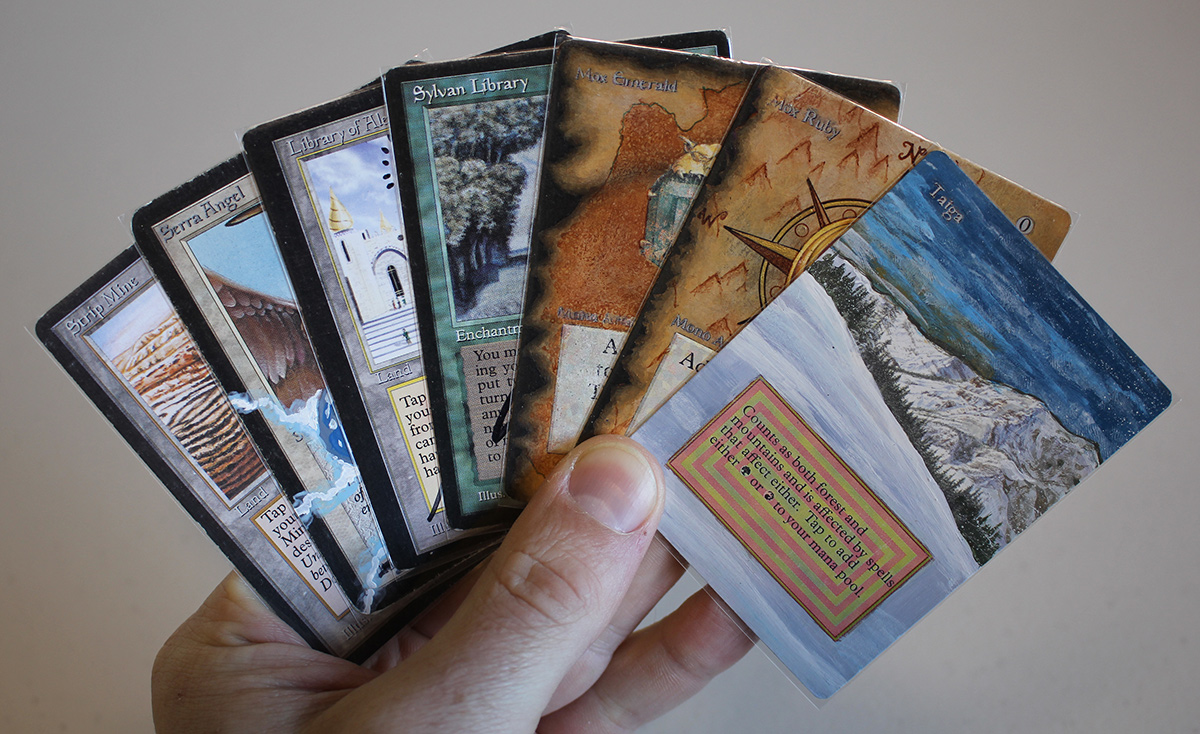
This is the best opening hand we’ve seen yet, with Library, Strip Mine, fast mana, and Sylvan Library. If you suspect your opponent is playing a 4 Strip Mine deck it might be correct to lead with your own Strip Mine first, in order to induce them playing one to take yours out, setting the game back a turn. This would offer the possibility of shielding your Library from their Strip Mine, and is worth consideration. The other option is to lead with Library of Alexandria, and if they can immediately deal with that, Strip Mine their next land, drop your Moxes, cast Sylvan Library, and GO HAM.
Opening Hand 10
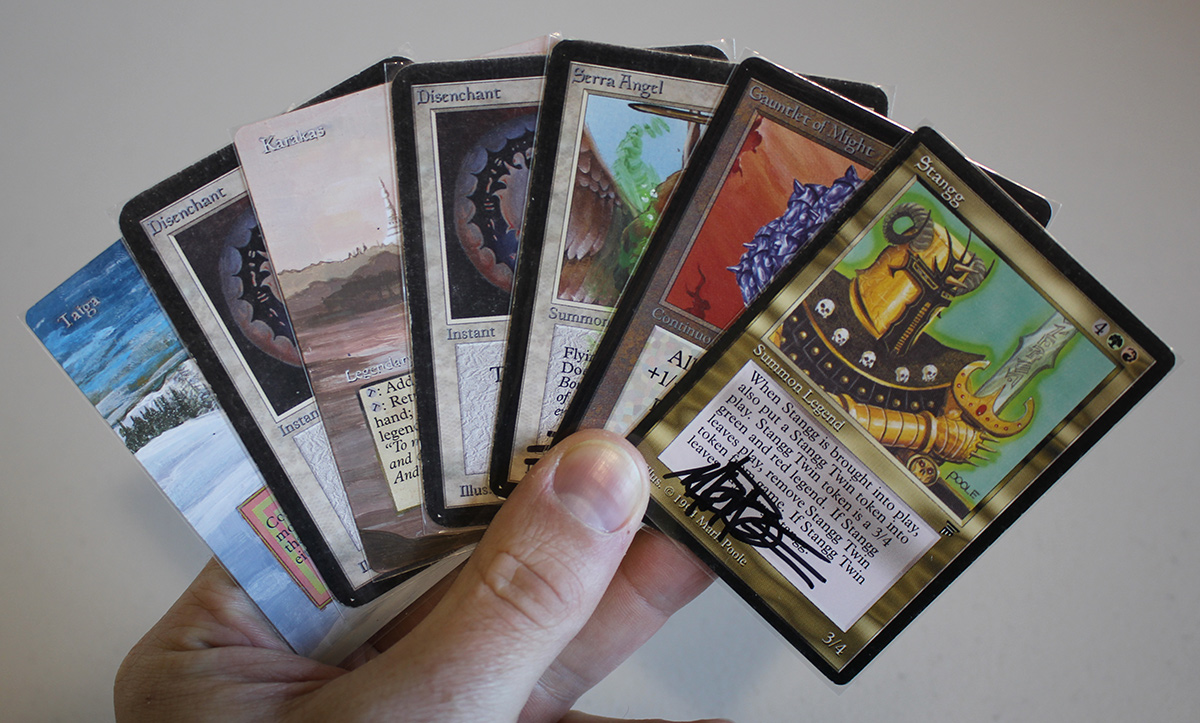
A stark contrast to the previous hand, this opener offers no acceleration, but does have enough mana to cast the Disenchants present. I’d probably begrudgingly keep this, and lead off with Taiga pass (shielding the Karakas for at least a turn, knowing that Disenchant is why we kept this hand). If our mana is not disrupted this will probably turn out fine, and we could hopefully curve out with Gauntlet, then Serra, then Stangg.
Concluding Thoughts
This is one of my favorite decks in Old School 93-94, because I love Sylvan Library, Stangg, and Hazezon Tamar. They perfectly embody the Legends expansion, which was wrought with both brokenness and underwhelming efficiency, debuted interesting mechanics and effects, and was draped with undoubtedly some of the coolest art in Magic’s history.
Stay tuned to Eternal Central for more sick 93-94 brews all month long. Thanks for reading.

